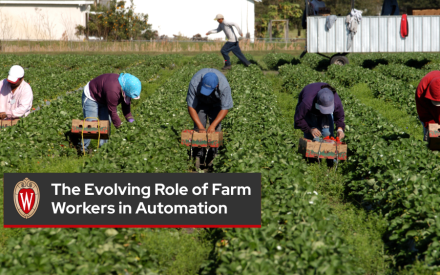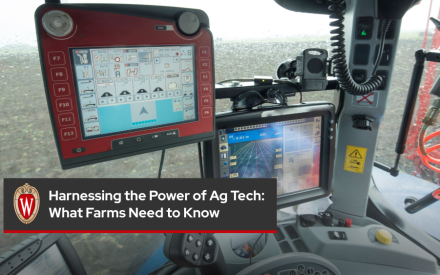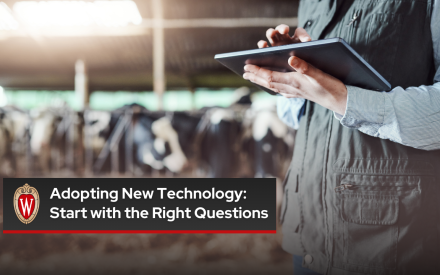Introduction
Technology and automation continuously reshape the work of running a farm. A little more than a century ago, farm chores relied on people’s hands and backs along with the work of horses, steam engines, and early tractors and machines. Today in Wisconsin and the wider Midwest, robotic milkers, automated feeders, driverless tractors, virtual fences, and drones are just starting to handle daily tasks. Elsewhere robots pick fruit, spray crops, or fry weeds with lasers. Automation is no longer a distant vision. Technology is being used to fill labor gaps, trim costs, increase efficiency, and boost precision.[1] Success, though, still begins with a solid plan.
Exchanging Physical & Mental Effort with Tech
- Be Clear on Why You are Changing
- Know the Current Numbers
- Set Clear Goals
- Do Your Homework Before Shopping
- Ask the Right Questions Before Committing
Exchanging Physical & Mental Effort with Tech
Whether we are talking about an automated milking or feeding system today, or a driverless combine or forage harvester in the future, the goal of automation is simple. It helps us replace strenuous physical and mental work with machines, sensors, and computers. Regardless of form, engineers design automated solutions to save time, reduce drudgery, protect human bodies, and decrease the injuries and stress that often accompany farm work.
At the same time, bigger forces are driving agriculture’s desire for technology. Many farmers struggle to hire workers.[2][3] Farm workers who get stretched too thin day after day can face burnout, which then leads to employer issues with hiring and retaining good help. The tough work of agriculture also carries with it a stubborn reputation that farm work is too grueling for workers who may have other options. Increasingly, those who have worked much of their adult life on a farm sometimes discover that they might have other job opportunities that can lead them to a better work-life balance or other tangible benefits. The labor shortage is real and it is likely to continue.
Additionally, input costs have been unpredictable and continue to rise. Farms are seeking ways to enhance quality and efficiency to stay competitive. Automated, computerized systems can sense the condition and specific needs of both animals and plants and can more easily target production needs like water, fertilizer, pesticides, or feed with greater precision. This is particularly useful in addressing the needs of individual animals like cows and calves, controlling weeds or insects with more precision, and meeting the nutrient needs of smaller fields or even specific areas within a large field.
But buying new technology takes careful planning. You need to think through what you want to achieve. The best results come when you follow a clear process.
This article will walk you through five critical steps that can help guide your decisions.
1. Be Clear on Why You are Changing
First, ask yourself: Why do I want to replace a particular job with a higher-tech machine or system? You may have several reasons. You may feel strongly about some of your reasons, and with others, it might just be viewed as something that would be nice to have or do. Or you might simply find yourself interested in tech as an early adopter or innovator and you enjoy the challenge of experimenting with new ideas. Your answers on the “Why?” question will shape the decisions that come next.
Here are some common reasons we hear from farmers:
- You hate doing a particular job (it might be overly strenuous, boring, dangerous, or you might have other personal reasons for your aversion).
- Family members dislike it too. This could affect whether the next generation wants to farm, so it’s also a question connected to farm succession. Many producers love spending full days in the cab of a tractor or having direct contact with cows 365 days a year. But, this may not be the case for everyone connected to your operation.
- You can’t find enough workers now to take on specific jobs and roles, and you don’t expect that to change.
- You want to protect your health and well-being over the long run. A lot of farm work done over 20-30-40 years takes a physical toll or leads to injuries.[4] It’s common in the dairy and livestock industry for producers to face the need for joint replacements and other medical needs that can be costly and impact quality of life.
- You want to grow your farm by adding animals or crop acres, but do not want to hire more people.
- You want to cut back on your work hours and have more time with family or for other opportunities while maintaining current levels of production.
- You want to improve profitability through reduced costs, increased revenue, and/or greater efficiency.
There may be other reasons not listed here, but it is important to be very clear and precise about your “Why’s.” Don’t buy technology just because it seems cool and interesting. Buy it because it solves one or more of your “Why’s” and helps you address specific problems and opportunities on your farm.
2. Know the Current Numbers
Once you are clear on your “Why”, you need to understand how work is getting done today and the metrics and numbers that are connected to the processes, tasks, machines, and systems you hope to change.
You can’t rely on rough guesses. You need accurate data over a range of time and conditions. Don’t just use the numbers from the last couple of months, but look back over at least a couple of years or growing seasons so that you understand and can put numbers to the highs, lows, and trends.[5] Also, consider your financial situation during times of high input costs or low product prices. For example, a robotic dairy system might end up looking highly attractive when electrical prices are low and diesel costs are high, but the situation will change as energy and milk prices fluctuate up and down. Here are some examples of numbers to track:
- Total hours spent in the field for each operation for tasks like planting, spraying, harvesting, transport, nutrient application, etc.
- Annual labor cost per 100 cows or per acre.
- Hours each person in the operation (including you as the owner/operator) spent each week on tasks like feeding, milking, moving animals, animal health tasks, and others.
- How many full-time and part-time workers you have now and during each month of the year. Also consider metrics connected to hiring and pertaining workers. For example, what is the cost and time required to hire new employees? What is your annual turnover rate?
- Fixed and variable equipment costs, including repairs (and anticipated changes in repair costs as equipment ages) and the cost of downtime. The initial automation investment can be significant and tends to rely more on fixed versus variable costs. Fixed costs, sometimes thought of as “DIRTI” (depreciation, interest, repairs, taxes, and insurance) are all critical. Automation assets often depreciate faster meaning the need to re-invest comes quicker. Thus, you will need to know firm numbers for purchase costs, installation, useful life, and salvage value.
- Current energy costs – Most farms that have a more limited degree of automation rely heavily on traditional fuels like diesel and gasoline. But, electrical costs are also significant in many parts of a more automated operation. If you were to make a switch from a diesel-based feeding setup to one that relies more on work done by electrically-powered machines or robots, you need good numbers on today’s electricity costs to make accurate comparisons for future investment.
- Since automation can increase revenues or create greater efficiencies, make sure you clearly understand and have accurate data on the range of production impacts as yields or per-animal production changes. Ensure that you have considered how these impacts change under different weather, economic, or policy scenarios.
- Automation may change your risk profile. So it is critical to consider which risks might be reduced or eliminated by automation versus what risks are new or increased. An example might be the insurance costs to cover risk to new machines and technology systems as compared to the cost of covering all hired workers with worker’s comp insurance.
These numbers help you see where your time and money are currently going. They also give you a baseline. An accurate baseline is essential for comparing the benefits of current systems against future tech investments. Do NOT rely on financial assumptions provided by a vendor looking to sell you a new machine or system. Their numbers may assume your current situation to be much less favorable than it really is, skewing your decision and perhaps leading to disappointment.
3. Set Clear Goals
Now it’s time to set your goals.[6] Obviously, your goals need to connect to the motivations to change that you explored earlier. That is, your goals must connect to your “Why’s.” Consider your goals over a longer time frame. Most likely, significant investments made today will be with you (and you will still be paying for them) over at least 5-10 years and probably much longer. Take some time to consider how your operation will evolve over the next two years, five years, and ten years regardless of the types of technology you are using. A producer with high school-age kids today will be the parent of young adults in ten years, maybe with their own families and needs. If you are 55 years old today, age will impact your abilities, health, and possibly your desires to work differently in 8-10 years. So, think into the future.
Here are some common goals:
- Take more three-day weekends, traveling vacations, or attend family events more frequently.
- Grow your herd or acreage by 40% without adding more labor hours.
- Improve production, efficiency, and quality with your current workforce.
- Lessen the time you and your workforce spends on jobs that create significant risk for health, safety, or that create excessive wear and tear on your body.
- Reduce worker’s compensation costs by automating specific tasks that are causing a high incidence of insurance claims.
- Set up a physical infrastructure and work environment that ensures the long-term economic viability that can support successful transition to the next generation.
- Strengthen your reputation with buyers and consumers to facilitate entry into broader markets and drive product growth.
One lesson that we’ve learned through discussions with various types of producers, from dairy farmers to specialty crop growers, is that the addition of technology and automation will likely not immediately or dramatically reduce the need for hired work. Labor needs will most likely change, as new technology requires a different skill set and may even increase your labor costs for a while as you settle into transitions that can take a year (or more). You will also need different skills among your work force if you move more toward a tech-based system. For more details on labor needs, see the previous article in this series Balancing Technology and People: The Evolving Role of Farm Workers in Automation.
Ensure you can clearly explain your goals and the numbers you’ve gathered and analyzed to inform your decisions. Your lender will ask about them. Ensure your goals align with your “Why” and your current performance metrics. When these are all aligned, it’s easier to choose the right technology.
4. Do Your Homework Before Shopping
Now that you know your “Why,” your numbers, and your goals, do not rush out to buy. Take time to do your homework first.[7]
- Talk to farmers who are using the type of system you’re considering. Make sure to talk to a range of producers including those new to change, and those with more experience. It is helpful to talk to those with operations similar to yours in terms of location, operation size, family situations, and other factors.
- Visit farms. Attend field days and farm shows. It’s important to see and touch things and to “kick the tires.” But, also realize that at farm shows and tech expos that vendors are there to sell. Be a smart buyer and ask lots of questions based on your preparation and homework.
- Ask people about the things that surprised them as they made tech-based transitions. This might include pleasant, positive surprises, or negative things that they wish they knew before going into their changes. Also ask them about the sometimes scary times while transitioning into new tech-based systems.
- Join online user groups where farmers talk about what works and what doesn’t. Be cautious about sharing personal or financial information.
- Watch YouTube videos – in many cases, you can find producers demonstrating new technology or talking about their experiences.
- Skilled labor typically earns higher wages. Consider surveying nearby industries to see what they’re paying employees who operate machinery or automated equipment, so you can stay competitive in your wage offerings.
You’ll learn a lot from other producers. They can tell you what went well, what surprised them, and what they wish they had done differently. Be an informed buyer when you meet with vendors. Ask thoughtful and well-informed questions, and avoid getting swept up in the sales pitch. Don’t be afraid to challenge and ask critical questions about the numbers others use, especially if their goal is to sell you a new product.
Technology will only continue to get better, and generally speaking, due to advancements and innovation and digital advancements, the capabilities you can purchase today are likely to get somewhat less expensive in the future. So, don’t be pressured into making changes. It is also a good idea to check out the used equipment marketplace. You may find equipment from a producer who has recently upgraded their operation or from a producer who has made changes for other reasons.
Also, check out federal and state incentive programs or grants that support technology adoption. While funding availability changes from year to year, programs run by federal agencies like USDA or state agencies may offer grant or loan programs to help offset upfront costs.
5. Ask the Right Questions Before Committing
System-level technology changes truly transform the entire system. For example, switching from traditional machines to robots will require changes in electrical infrastructure, training, needs for technical support, and vendor relationships. Many considerations require careful thought about all of the moving pieces and implications of a technology change. Before signing any contracts or writing a check, consider the big picture. Here are just a few to think about carefully.
How will the technology “physically” fit into your farm?
- Will your buildings need changes?
- Is there enough space to install new systems?
- Will structural changes be required to accommodate the load or footprint with new equipment?
Are there compatibility concerns?
- Will the new equipment work with what you already have?
- Will the software from different systems talk to each other?
Is your infrastructure ready?
- If you are considering robotics, or other electrical equipment, will your electrical system handle the increased load? If not, what will it cost to upgrade?
- Will you need changes in your ventilation system, floor space, or space to accommodate charging stations?
Do you have good broadband access?
- Push hard for quality, affordable broadband.[8] Many farms still lack it.
- If you are looking at using satellite-based broadband, check all of the startup and monthly the costs, data limits, and speeds.
Are you buying more than you need?
- It is tempting to go “all in.” Resist the urge.
- Start with what you need now to address your “Why’s” and your shorter term goals.
- Technology will keep getting better each year. It’s smarter to add new tools as your needs evolve and as you gain experience.
Can you count on your vendor?
- Where are they located, and will vendor support for repairs, maintenance, and upgrades be there over the life of the product you are considering?
- Will they provide fast, reliable service?
- Are their staff knowledgeable and will they have enough trained technicians to support you?
- If support is provided online, will your Internet service accommodate necessary data transfer, video consultation, and remote access?
Do you know your economics?
- What is the acquisition cost (purchase, installation, initial training)?
- What are the fixed costs?
- What are the variable costs (especially labor, energy, maintenance, subscription fees, and repair)?
- What changes in revenues might you expect?
It’s also important to make sure YOU are ready. While long term, technology might make work easier and more pleasant, the learning curve following a major installation of a new piece of production or field equipment is steep. It might take a full year or more to settle in and feel comfortable. It helps if you have strong skills and confidence in using your smartphone, a computer, and basic software for data analysis. Having a mindset of being able to make changes, adjust machine or control settings, and gather information from your current technology is also useful. If you struggle with tech, consider taking an in-person or online tech course. Many tech colleges offer basic computer and technology-based courses, or consider content connected to precision agriculture.
Final Thoughts
Farm automation often presents an exciting opportunity but it’s also a highly complex issue that will change the nature of your entire operation. And the financial implications cannot be overstated. Technology can help you get more done, with less strain and less stress. But it requires careful thought.
Be clear about your “Why”. Know your numbers. Set clear, measurable goals. Do your homework. Ask the hard questions. Consider giving yourself a structured timeline. For example, spend two to three months gathering baseline data, another month talking to vendors and visiting farms, and one the three months comparing specific options. Avoid rushing large purchases during busy seasons when time and focus are limited.
Take time to assess your management effectiveness. For instance, in the dairy industry, when activity monitors became popular over a decade ago, some producers adopted the technology hoping it would resolve reproductive challenges within their herds. However, these issues were often rooted in poor management practices. Introducing new technology without improving management can create the perfect storm for failure
Be cautious about buying more than you’ll use. If you don’t currently have it, advocate aggressively for accessible and affordable broadband so your farm is ready for the future. And always think about how new systems will fit into your farm and work together as a system.
If you follow these steps, you’ll be more ready to invest wisely and with confidence. For more tips and to assess how ready you are, visit Extension’s resources on Adopting New Technology—Start with the Right Questions.
References
- Gillespie, J., Njuki, E., & Terán, A. (2024). Structure, costs, and technology used on U.S. dairy farms (Economic Research Report No. 334). U.S. Department of Agriculture, Economic Research Service. https://www.ers.usda.gov/sites/default/files/_laserfiche/publications/109626/ERR-334.pdf
- U.S. Department of Agriculture, Economic Research Service. (2025, June 13). Farm labor: U.S. and state-level trends. https://www.ers.usda.gov/topics/farm-economy/farm-labor
- The Bullvine. (2025, June 25). The labor crisis hidden in plain sight: How dairy’s worker shortage will reshape your farm by 2030. https://www.thebullvine.com/management/the-labor-crisis-hidden-in-plain-sight-how-dairys-worker-shortage-will-reshape-your-farm-by-2030/
- Arachchige, S. D., Piyathilaka, L., Sul, J.-H., & Preethichandra, D. M. G. (2024). A review of potential exoskeletons for the prevention of work-related musculoskeletal disorders in agriculture. Sensors, 24(21), Article 7026. https://doi.org/10.3390/s24217026
- Penn State Extension. (2022). Equipment cost calculator. Pennsylvania State University. https://extension.psu.edu/equipment-cost-calculator
- Plaster, S. (2024). Make your strategic goals a reality. University of Wisconsin–Madison Division of Extension. https://farms.extension.wisc.edu/articles/make-your-strategic-goals-a-reality/
- Farm Progress. (2023, December 7). Check all options before investing in robotic milkers. https://www.farmprogress.com/management/check-all-options-before-investing-in-robotic-milkers
- Shutske, J., Vogt, W., Cornelisse, S., & Luck, B. (2023). Agricultural autonomy, technology & the future (Agricultural Safety and Health Program Fact Sheet No. A-ASH-FS-103). University of Wisconsin–Madison. https://uwmadison.app.box.com/v/AutomationFS3
- Mercier, S. (2025, April 18). Why reliable broadband access is important to U.S. farmers. AgWeb. https://www.agweb.com/opinion/why-reliable-broadband-access-important-u-s-farmers

 Balancing Technology and People: The Evolving Role of Farm Workers in Automation
Balancing Technology and People: The Evolving Role of Farm Workers in Automation  Harnessing the Power of Ag Tech: What Farms Need to Know
Harnessing the Power of Ag Tech: What Farms Need to Know Large Language Models: A Powerful New Tool for Wisconsin Agriculture
Large Language Models: A Powerful New Tool for Wisconsin Agriculture Adopting New Technology—Start with the Right Questions
Adopting New Technology—Start with the Right Questions


